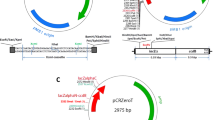Abstract
A novel method for the directional cloning of native PCR products was developed. Abasic sites in DNA templates make DNA polymerases stall at the site during synthesis of the complementary strand. Since the 5′ ends of PCR product strands contain built-in amplification primers, abasic sites within the primers result in the formation of 5′ single-stranded overhangs at the ends of the PCR product, enabling its direct ligation to a suitably cleaved cloning vector without any further modification. This “autosticky PCR” (AS-PCR) overcomes the problems caused by end sensitivity of restriction enzymes, or internal restriction sites within the amplified sequences, and enables the generation of essentially any desired 5′ overhang.
Similar content being viewed by others
Author information
Authors and Affiliations
Additional information
Received: 11 August 1998 / Accepted: 2 October 1998
Rights and permissions
About this article
Cite this article
Gál, J., Schnell, R., Szekeres, S. et al. Directional cloning of native PCR products with preformed sticky ends (Autosticky PCR). Mol Gen Genet 260, 569–573 (1999). https://doi.org/10.1007/s004380050930
Issue Date:
DOI: https://doi.org/10.1007/s004380050930




